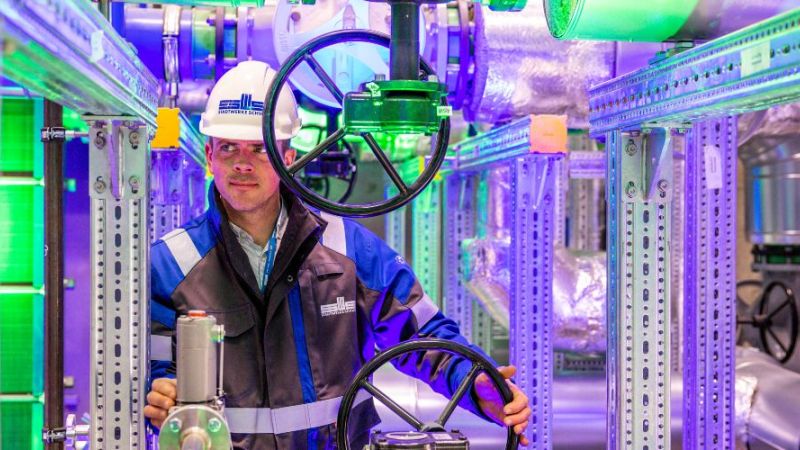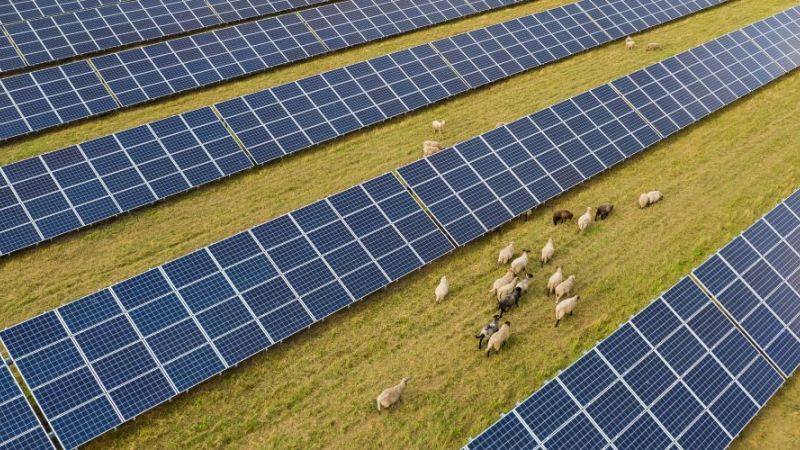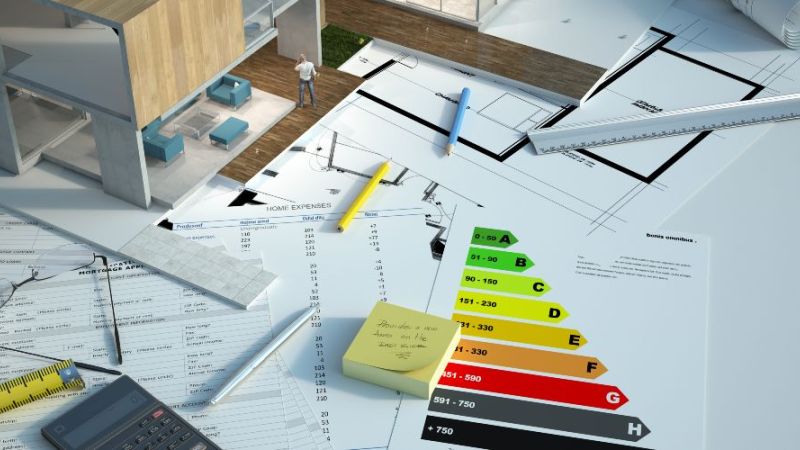Mission Electricity Transition 2045
"With innovations, we are creating a secure, climate-neutral and affordable electricity supply from renewable energies."
By 2030, the demand for electricity will increase significantly due to electrical innovations in transport, heating and industrial processes. By then, 80 per cent of electricity should come from renewable energy sources - instead of just under half at present. An ambitious target. After all, households, industrial companies and other stakeholders must be supplied with affordable and environmentally friendly electricity in line with demand. Increasing energy efficiency in all areas counteracts the increasing demand, but is not enough. The expansion of renewable energy generation plants must therefore be significantly accelerated and continued at a high level in the long term. The focus here is primarily on utilising wind and solar energy.
Wind farms and photovoltaic systems produce electricity depending on the weather. This places new demands on the grids. Many thousands of decentralised systems are already feeding in electricity at different times, and the trend is rising. This means that the electricity grid must be further expanded, digitalised and also designed to be secure against possible cyber-attacks or extreme weather conditions due to climate change. In addition, the many decentralised electricity producers and consumers need to be efficiently and intelligently networked, for example using smart meter technology. Overall, the electricity transition will make a decisive contribution to Germany becoming climate-neutral by 2045.
In order to achieve the targets set, the expansion of environmentally friendly energy generation plants must be significantly accelerated and continued at a high level in the long term. Wind farms and photovoltaic systems will continue to produce the majority of electricity in the future. In addition, other renewable energy sources such as hydropower and biomass will contribute to a resilient and reliable electricity supply.
1.1 Increasing efficiency in electricity production and reducing costs
In order to meet the demand for electricity and reduce electricity costs, more powerful, more reliable and lower-maintenance systems with a longer service life are needed. With the help of energy research, components and systems are to be manufactured automatically and standardised plant types developed. Digital methods and new condition monitoring procedures should optimise operation, reduce the operating and maintenance costs of the systems and increase security of supply.
1.2 Further develop technologies to diversify electricity production
The use of different technologies and energy sources contributes significantly to the resilience of an energy system. In order to supplement weather-dependent electricity production from wind and solar energy, synthetic or biogenic fuels are to be used in flexible power plants of various output classes. The combination of several renewable energy sources and storage technologies is also an option.
1.3 Improving sustainability and acceptance for renewable energy plants
Social acceptance is necessary for a successful electricity transition. The issue of sustainability plays a major role here. For example, all renewable energy generation plants must utilise materials and resources as efficiently as possible over their entire life cycle and significantly reduce CO2 emissions during production, operation and dismantling.
The electricity grid must fulfil a wide range of requirements and continue to ensure security of supply and system stability. To achieve this, the grid must be expanded on the one hand and digitalised and thus made more flexible on the other. This is the only way to harmonise the volatile feed-in of electricity and its consumption by a wide variety of players.
2.1 Providing ancillary services through renewable energies and consumers
In a decarbonised energy system, the ancillary services in the electricity grid must also be climate-neutral. This includes grid congestion management, redispatch and ensuring voltage quality and black start capability. To this end, concepts and technologies are to be developed that optimise the interaction between renewable energy plants, electricity storage systems and consumers through new control strategies and market mechanisms.
2.2 Improve grid planning and operation
Electricity grids must be planned and expanded with foresight. To this end, innovative planning tools and data analysis methods must be continuously developed. In the sense of integrated planning, the heat and hydrogen grids as well as flexible large-scale consumers and storage systems must be considered alongside the electricity grids.
2.3 Further develop grid operating resources
In order to ensure a reliable power supply in an increasingly decentralised and flexible system, power converters, controllable transformers and power electronic components must be further developed. High-voltage direct current (HV-DC) and alternating current (HV-AC) lines, for example, can be used to transmit electricity efficiently over long distances.
In future, electricity from renewable energies must be utilised even more efficiently than before. Electricity storage systems are an important option here. They can make the energy system more flexible by also storing electricity in other forms of energy. The storage systems can also absorb peak loads from industrial operations or energy plants and thus stabilise the electricity grid, among other things.
3.1 Increasing energy efficiency in industry and commerce
Germany is home to large-scale industry and a large number of small and medium-sized enterprises. In addition to the electricity-intensive processes in large industrial plants, there are also considerable opportunities to significantly reduce electricity consumption in smaller companies. For example, production processes should be optimised or replaced by more efficient and climate-neutral processes. In addition to electrically powered units and systems and their control systems, energy-efficient procedures and processes need to be developed and refined.
3.2 Further develop electricity storage technologies
Electrochemical storage systems can be used in a variety of ways. In addition to the lithium-ion batteries already in widespread use today, battery systems with alternative cell chemistry need to be developed. They should reduce the use of scarce and expensive materials. To store large amounts of energy over longer periods of time, high-temperature heat storage and compressed air storage, among other things, should be further researched. Electrical energy can also be converted into chemical energy carriers such as hydrogen for large-scale and flexible storage.
In future, many additional electricity consumers such as electric vehicles or heating systems will need to be integrated into the distribution grids. This will require flexible storage and consumption systems as well as corresponding digitalisation. By creating market incentives for flexible consumers, the electricity grids can be better utilised. Energy research should provide relevant technologies and their system integration for this purpose.
4.1 Utilising decentralised flexibility options through control concepts
Precise models should analyse the effects on the energy system when a large number of decentralised systems are integrated into the electricity grid within a short period of time. On the one hand, the technical influences of inverter-based systems on the stability of the electricity grids are to be analysed. On the other hand, the integration into the different markets for electrical energy should be carefully designed. Another aspect of the research is how decentralised systems and local and regional energy management systems can be intelligently controlled.
4.2 Ensuring secure and efficient digital communication
The smart meter gateway is the key technology in the digitalisation of the energy transition. The gateway makes consumers an active part of the energy transition and drives it forward by communicating with electrical appliances, generation plants and the electricity grid while fulfilling the highest security requirements. The functions it provides must be continuously developed to enable innovative applications while ensuring operational and data security.
4.3 Developing new business models
The participation of new decentralised players in an increasingly climate-neutral energy system enables innovative and sustainable business models. An important business area is measurement data-based services, such as user-orientated operational adjustments and security services. Energy management and intelligent converter technology enable electric vehicles, the heat supply and other systems to interact optimally. This offers opportunities for further services.
Sprinter targets
Sprinter targets are short and medium-term goals to be achieved within a research mission to support the achievement of a climate-neutral and secure energy system by 2045 through energy research.
- Sprinter target 1
By 2030, high-performance generators for wind turbines in the 15 MW class will be available at higher rated speeds and, where possible, without the use of critical raw materials. - Sprinter target 2
Secure technological sovereignty: Over the next five years, the establishment of a complete photovoltaic value chain in Germany and the EU will be supported by intensive research and development. - Sprinter target 3
Over the next five years, the stable operation of the electricity grid (including storage) will be demonstrated on a large scale in a defossilised subsystem (electricity grid and possibly in combination with heat and hydrogen grid).






